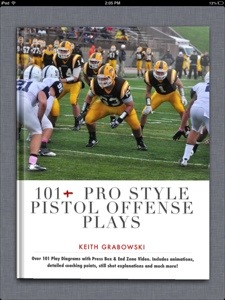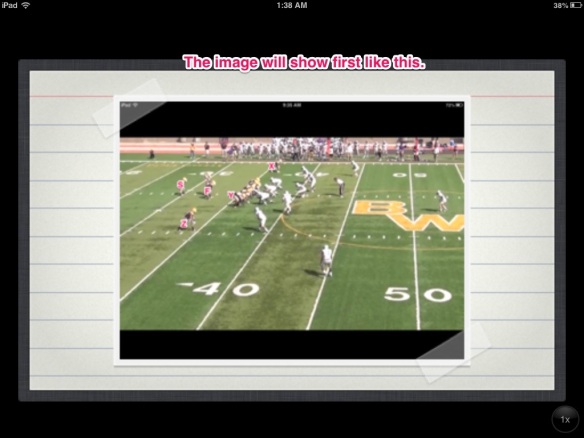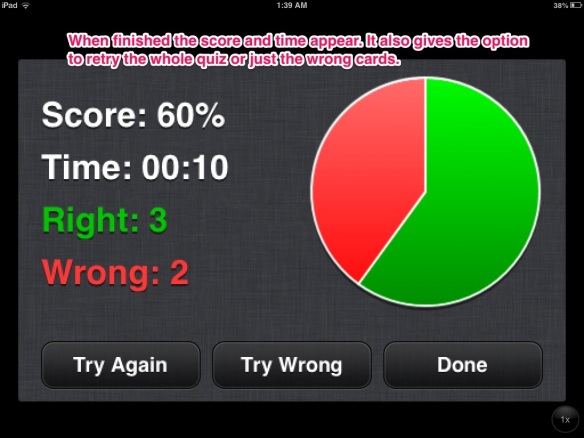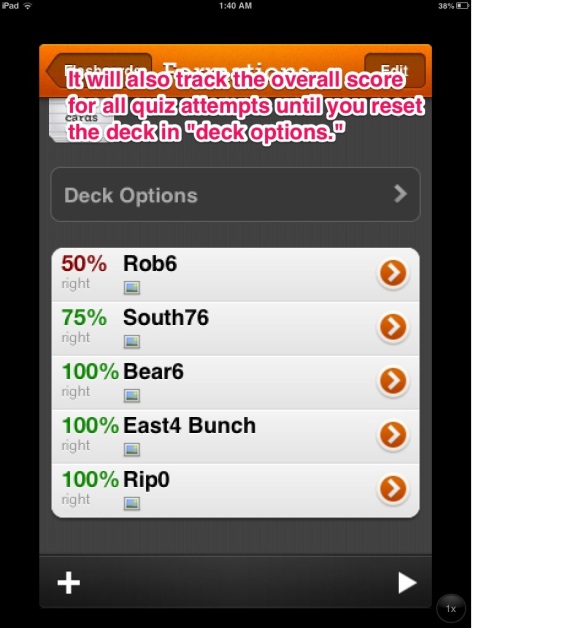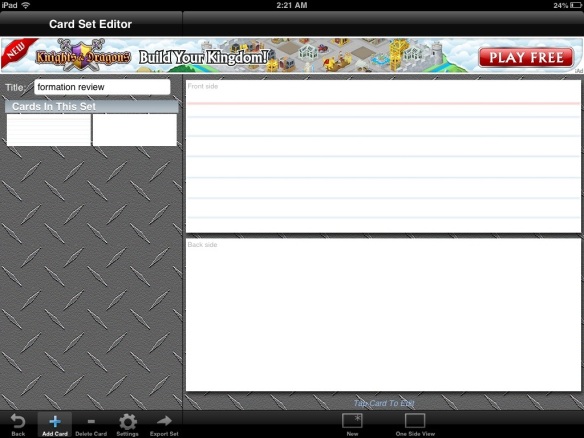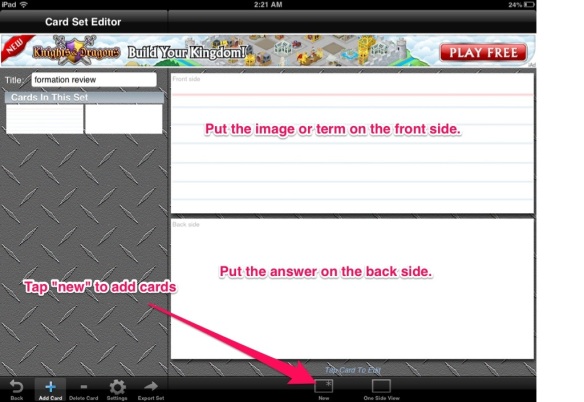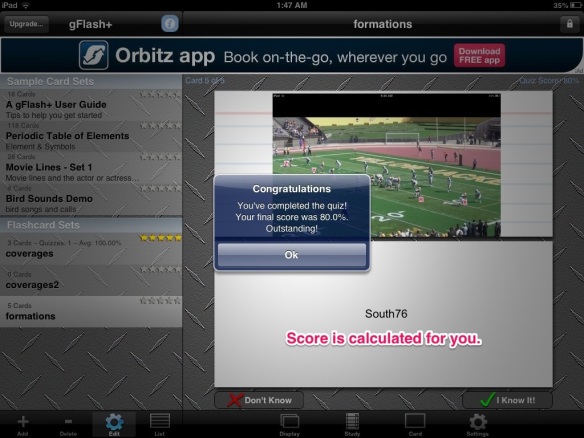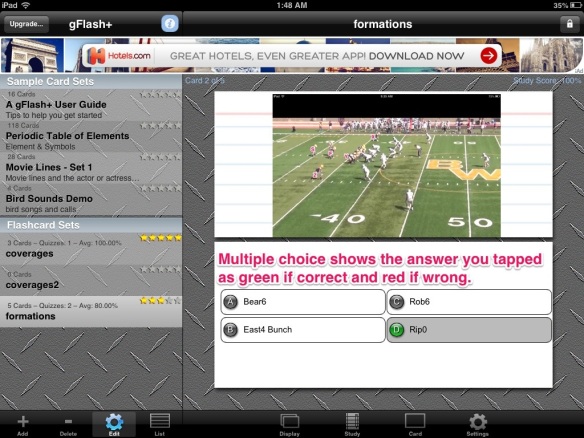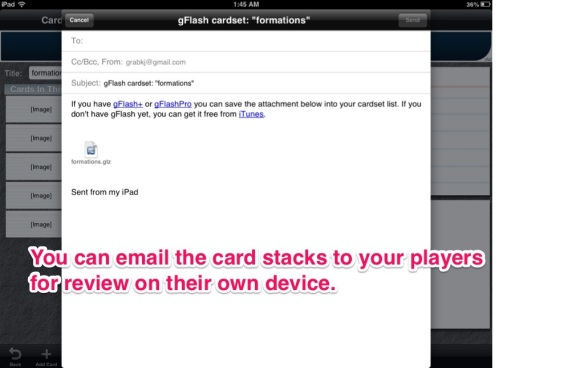I just finished an interview on the pistol offense on “The Red Zone Show” Internet radio. Catch it here: http://www.coachbigb.com/one-on-one-w-coach-keith-grabowski-pro-style-pistol-attack
Monthly Archives: August 2013
Keep grinding, but interject fun
Camp is always a grind, and when it occurs simultaneously with the beginning of classes, there is always the danger of having an unfocused practice. After a tough weekend of practices, our players were feeling the grind of camp. The first day of classes has typically been a day where our practices haven’t been as crisp. We decided to help combat that by adding some fun and pranking one of our sophomore quarterbacks. We set him up by me pulling him out of a team meeting and while he was out explaining to the players what we would do in the first play of period 14. We borrowed this one from UNC who did the same thing in their camp. We involved all 160 members of our team. The results are below.
Every now and then, we need to do something to lighten things up. It might be in the week leading up to a big game when tensions are high. It could be during the grind of preseason camp. As a coach, you need to be cognizant of what your team needs. This short interjection of some humor made practice fly, and we had the best first day of classes practice since I have been here.
Pete Carroll is the master of pranking his team. Here is one involving Will Ferrell.
Even the usually serious and intense Bo Pellini pulled a prank on his team.
Good luck this season. Have fun!
Pick up a great resource and reference for the 2013 season. 101 Pro Style Pistol Offense Plays for the iPad is loaded with video, diagrams, and ideas that are useful in any offense. Get it here: https://itunes.apple.com/us/book/101+-pro-style-pistol-offense/id611588645?mt=11
iPad at practice is an invaluable coaching tool!
We utilized the iPad in practice today for the first time and our coaches and players loved the instant feedback. If you have and iPad and the Hudl app you will love it too. Even without the Hudl app there are plenty of answers for video. Wifi wasn’t necessary to use Hudl because you don’t need to upload to view the videos.
This was an idea I got from watching Nebraska. If you haven’t seen the video yet, here it is.
Our TE?FB coach used it to review inside run with his players. They though it made a difference. Our OL coach said, “I didn’t use to review every play, but when we needed it to correct something that happened on a blitz pick-up, we had it.” The players could see exactly what they needed to do if they faced that situation again. The feedback was instantaneous.
I told our equipment manager I needed a tent with a flat screen set up as a viewing station. He laughed at me, but it would be great to pull a group in between reps and view on a bigger screen…I’ll keep working on this one.
Even with the small screen of the iPad, players seeing what happen was great for their learning and understanding.
If you haven’t seen some of my posts on using technology to enhance coaching, check them out by clicking the links below:
Making an Impact with Flipped Coaching
Improving Learning Through the Use of iPads
Using the iPad for Scout Cards
Pick up a great resource and reference for the 2013 season. 101 Pro Style Pistol Offense Plays for the iPad is loaded with video, diagrams, and ideas that are useful in any offense. Get it here: https://itunes.apple.com/us/book/101+-pro-style-pistol-offense/id611588645?mt=11
On AFM: Making an Impact with Flipped Coaching
In the August/September of American Football Monthly, I describe a method known as “flipped coaching.” This coaching method is something borrowed from classroom teachers. “Flipped learning” is a teaching method developed by Jon Bergmann and Aaron Sams. These two chemistry teachers realized they had an innovative way to present the lecture portion of their lessons in a way which every student could progress at the pace which worked for them. Some students could move on and go deeper into the subject, and others could review the subject matter again and again if needed until they understood it. The primary way they accomplished this was through screencast videos of their lessons. The results were that their students scored better on tests and understood chemistry at a much deeper level…read more
O,D & Special Teams Objectives That Promote the Team Concept
Many of us list objectives for each of our units and review those with the team following the game. At BW we do it a little differently. Our head coach John Snell realized in his time as an assistant that the pride that each unit took in accomplishing their objectives many times turned into finger pointing. If it wasn’t explicit, it seemed to at least be an implicit understanding that, “We did our job, but you didn’t do yours.” This kind of attitude causes tension within the team and staff and ultimately fractures the team concept.
To remedy this, a team objectives system was put into place, and each unit evaluates what we refer to as “efficiencies” on their own. The chart above shows each one of the team goals, and the performance of offense, defense and special teams is factored into each one.
The first one is Win. This is easily evaluated, and is the most important objective.
Next is Takeaways/Turnovers. We factor in not only fumbles and interceptions, but also three-and-outs. Four three-and-outs count as a give away for our offense or a takeaway our defense. Special teams turnovers factor in as well. When we total up our takeaways vs. the opponent’s takeaways, we want to come out on top.
Fewer penalties is pretty self explanatory. We want less total penalty yards than the opponent.
Field Position Battle involves calculating the average starting field position for both ourselves and the opponent. We want to have a better starting field position than our opponent.
Big Plays encompasses many different things that can happen on offense, defense and special teams. They include a gain of pass of 20+ yards, special teams TD, 2-pt play, blocked kick, tackle for loss or sack, TD, game winner, punt inside the 10, onside kick recovery, INT, fumble recovery, stopped fake kicks, execute a fake kick, punt over 50 yards, 40 yard field goal, 20+ yard return, 10+ yard run, kick off downed inside 20. Any one of these counts for both us and our opponent. When we calculate big plays of each team, we need to have more in order to accomplish this objective.
Scoring Zone Efficiency. We want our Red Zone (20 and in) scoring efficiency to be better. We calculate this by number of drives inside the red zone that scored divided by total number of drives into the red zone.
Outgain Opponent. We calculate total net yards which includes rushing, passing , and returns for each team.
Compete for Four Quarters is the only subjective category we have. As a staff we evaluate whether we felt our team competed for the entire game. This includes any opportunity that the second team may have had. What we are guarding against that is regardless of score we never see our team ease up.
These have been great tools for us to evaluate how we are doing as a team. We always take the opportunity to grade individuals and units, but those don’t get presented in the framework of reaching an objective. Again, the team concept is very important to us, and we always want to shoulder responsibility for the win or the loss together.
Hopefully this idea sparks some thought on how you can continue to build a tight knit team. Good luck!
Pick up a great resource and reference for the 2013 season. 101 Pro Style Pistol Offense Plays for the iPad is loaded with video, diagrams, and ideas that are useful in any offense. Get it here: https://itunes.apple.com/us/book/101+-pro-style-pistol-offense/id611588645?mt=11
Defining Discipline
As coaches. the more we can define the different qualities we want to see in our players and our team, the better the chances of them being able to adopt those characteristics and perform up to the expectations we set for them. Many times we throw out terms that are intangibles. We assume that they understand the intangible, but we take for granted that their definition may be different than ours.
It is pretty safe to assume that our players understand that discipline is something that leads to success. What they view as discipline may vary. Merriam-Webster defines it as
Thought for the day…Attitude must be married to Effort
The above sign is in our quarterback manual. It’s something I originally saw in the Ball State team room when Brady Hoke was there as the head coach.These are valuable words because it puts the focus not just on a mindset , but action.
Blame no one. It starts with an internal focus. When something doesn’t go right, it doesn’t start with placing blame, it should be a chance to reflect and understand what you can do better because you can always do something better. Blame has no place in a team setting. Blame for a team failure is something that needs to be shouldered together. Placing blame on others, whether done by the coach or player, fractures the team concept.
Expect nothing. As a player or coach you want to have a positive mindset that you will win. However, don’t expect the other team to come in and lay down for you. No matter how bad they are, they are going to fight. Welcome the challenge of competition. Don’t expect the calls to go your way. Officials will make mistakes. They may even have biases. Don’t expect the ball to bounce the right way or the breaks of the game to go in your favor. You need to keep working and put yourself in a position to deserve to win.
Do something. Positive thoughts and words are a great start, but without action they are nothing. Effort must always be married to attitude. Without effort all the positive words ini the world are useless. Work harder; work smarter; do whatever it takes to gain the advantage. It’s all about taking actions every opportunity you have to improve. It will build incrementally and propel you towards your goal.
Pick up a great resource and reference for the 2013 season. 101 Pro Style Pistol Offense Plays for the iPad is loaded with video, diagrams, and ideas that are useful in any offense. Get it here: https://itunes.apple.com/us/book/101+-pro-style-pistol-offense/id611588645?mt=11</a
Repetition, Retention and Understanding: Flash cards to train your players
The iPad or iPhone/iPod Touch with flash cards is a great tool to teach something as simple as the basics of your offense or something more complex like weekly coverage indicators for the quarterback.
With any technology you add as a coaching tool, you will want to get maximum efficiency; you want to spend little time in creating the material and get a big impact from the use of the technology.
A flashcard app called Chegg gives you exactly that. It allows you to import images. Taking a screenshot from Hudl or any other video on your iPad is easy, and then that image can be imported as one side of the flashcard with the other side giving the answer. Players can start the quiz and put the card in the correct pile or incorrect pile. When they get through all of the cards they get a percentage score of how many they got correct. They then have the option to start the quiz again or only complete a quiz on the wrong pile of cards.
Another app I tried and like is gFlash+. I liked this app as well. It gave me the ability to have multiple choice answers for each card. When choosing the multiple choice mode, it scores it for you as right or wrong. Like Chegg it provided feedback on the number correct. I really liked that you have the ability to email your stack of cards to other people. I see this as a great advantage. The email provides a link to the app store so they can download it to their iPhone or iPad. Now they can take a few minutes between classes, eating at the cafeteria, or walking to class to review what they need to know. The only thing I don’t like is that ad banners run across the top of the free version. Because of the ability to share the cards with players, this will be the app I use.
Mental Case 2 was third app I really liked because it had the ability to use video in the flashcard. The only problem is I’m not quite sure how to get hudl video into the iPad photo library without going through several steps. I just don’t feel that currently this would be an efficient use of time. I could see this as creating video flash cards for install, but during a game week I’m not sure if I’d have the time to go through those steps. This one gives many more options, but I would see this as a spring ball or camp install use only. This is an app that seems very powerful in aiding in the teaching of concepts and I plan to explore it more.
I like the first two apps because they are simple to use and the player mentally drilling with the flashcard is given instant feedback.
This is something I will definitely be using. Here are some uses I see for the flashcard apps:
Key terms in our offense
Learning of formations
Learning of run and pass concepts
Coverage indicators for our next opponent
Opponent personnel tips
Weekly front recognition for our offensive line
Blitz indicators for our next opponent
Quarterback checks/audibles
Key information from position tip sheets and game plan
I plan to give our players the game plan and tip sheet information as we normally do at the beginning of the week on Hudl. At the same time I plan to give them the stacks of cards via email. Now the players have the info and a study tool to check their progress on heir own throughout the week. At different intervals throughout the week I will use the Socrative app (for more on this app click here) to quiz them with the final quiz coming on Friday.
Repetition, recognition and understanding are the keys for success on the field. Having something like this for our players to come in and spend a few minutes between classes to review is a useful tool. What will only take a few minutes for me to create can enhance their learning and give them the knowledge they need to be successful on the field.
Pick up a great resource and reference for the 2013 season. 101 Pro Style Pistol Offense Plays for the iPad is loaded with video, diagrams, and ideas that are useful in any offense. Get it here: https://itunes.apple.com/us/book/101+-pro-style-pistol-offense/id611588645?mt=11</a
Here are the links for the App Store:
Chegg
Levels of Commitment
The image above is another great tool and visual to help your team grasp the level of commitment needed for success. Our tight ends coach, Pete Peterson shared this with us. He was given this tool by a high school coach at Delaware Valley High School. That coach adapted it from what he saw Al Golden present.
This is like the “Commitment Continuum” and “Leadership Ladder.” It gives a visual representation to the players that the players can use as self evaluation, and it certainly is a great talking point with players on what the need to start doing to get themselves to the next level.
There are so many things that we do to build leadership and commitment in our programs. I think the best ones are those that can help your players with tangible evidence based on their actions rather than by just what they say. It’s easy for guys to act “rah-rah” but actions always speak louder than words. Action-based leadership is lasting and strong.
I included a Powerpoint file with this in case you would like to adapt it for use with your team.
Good luck in your preparations for the season!
Pick up a great resource and reference for the 2013 season. 101 Pro Style Pistol Offense Plays for the iPad is loaded with video, diagrams, and ideas that are useful in any offense. Get it here: https://itunes.apple.com/us/book/101+-pro-style-pistol-offense/id611588645?mt=11
Get vocal…teaching your players to be vocal leaders
I’m sure most of you have some great leaders by example that you can point out all of the time. The challenge is getting great vocal leadership from your team as well. In meetings with my players over the years, many of them would point out, “I’m kind of quiet, but I’m a leader by example.”
Unfortunately, in this game and in life, that is never enough. In order to be successful, a team must communicate. Most importantly, they must understand how to communicate with each other.
I decided to give them three simple ways to be more vocal and I posted a simple visual reminder. I presented it not as a way to be a leader, but as a way to be a great teammate. The three ways to be a great teammate are:
1. Recognize a teammate’s effort or performance. When your teammate does something well, speak up and show your appreciation because when your teammates do well it impacts you as a member.
2. Help a teammate improve. If a player sees his teammate do something incorrect, he should let him know what he saw and if he understands the proper way, he should coach him. Teammates need to serve each other.
3. Challenge a teammate to do his best. This can be before a rep or play. “Let’s go Joe, I know you’ve got this!” Or it can be after a play, “You’re better than that, Joe!” Or “You need to step up. I know you can give more.”
Always Positive…whatever message the player communicates to his teammate, it should be done in a positive way. As a coach you want to create a positive environment of communication.
Good luck developing your team as you continue through camp.
Pick up a great resource and reference for the 2013 season. 101 Pro Style Pistol Offense Plays for the iPad is loaded with video, diagrams, and ideas that are useful in any offense. Get it here: https://itunes.apple.com/us/book/101+-pro-style-pistol-offense/id611588645?mt=11

